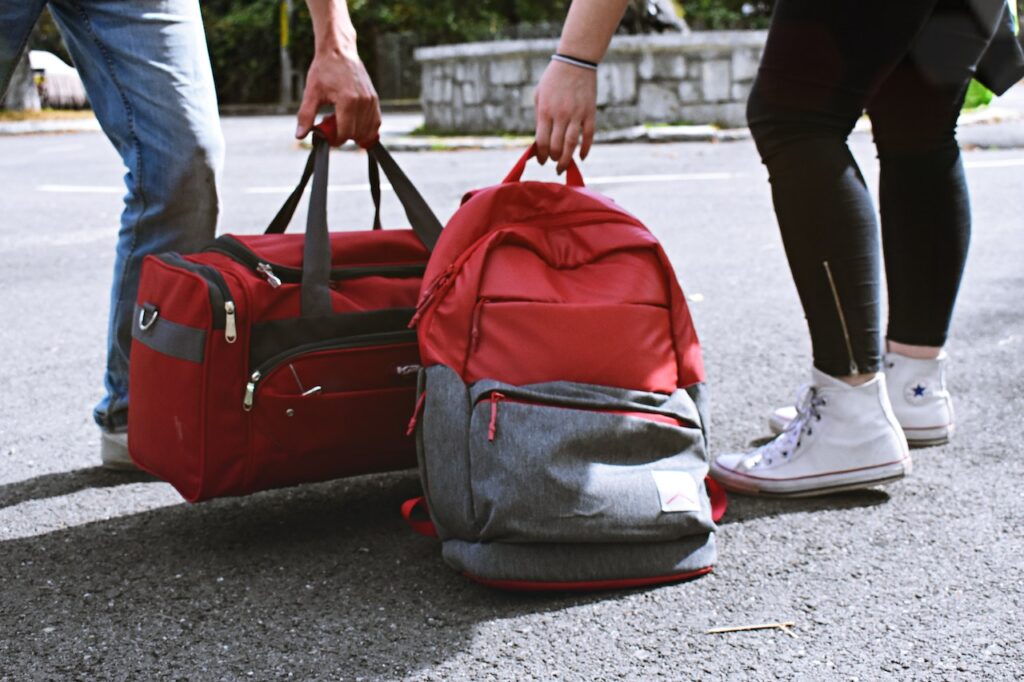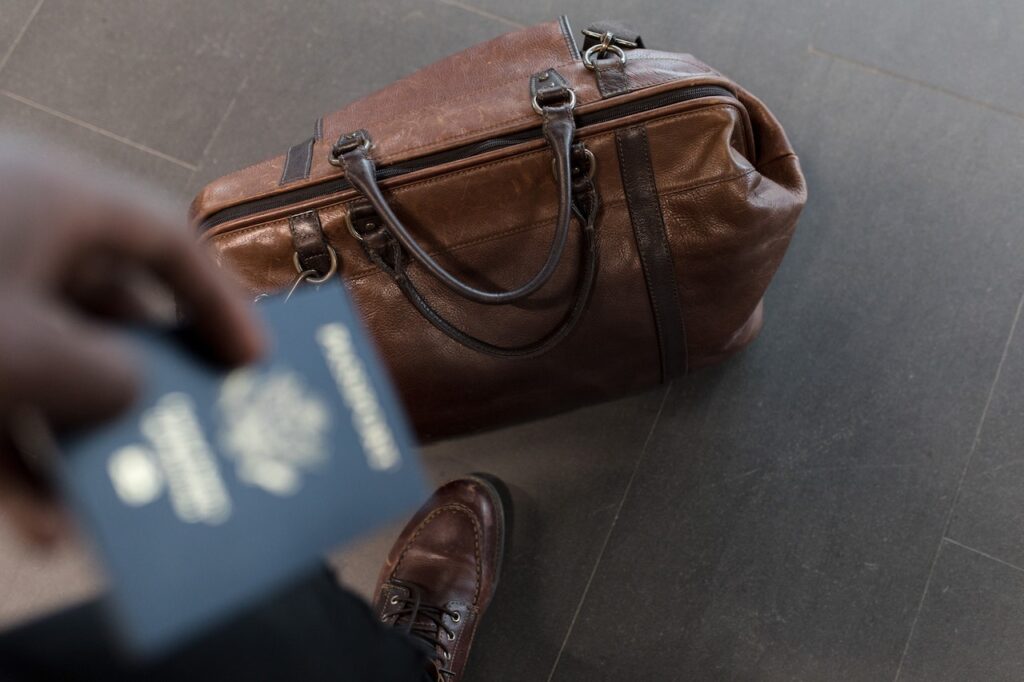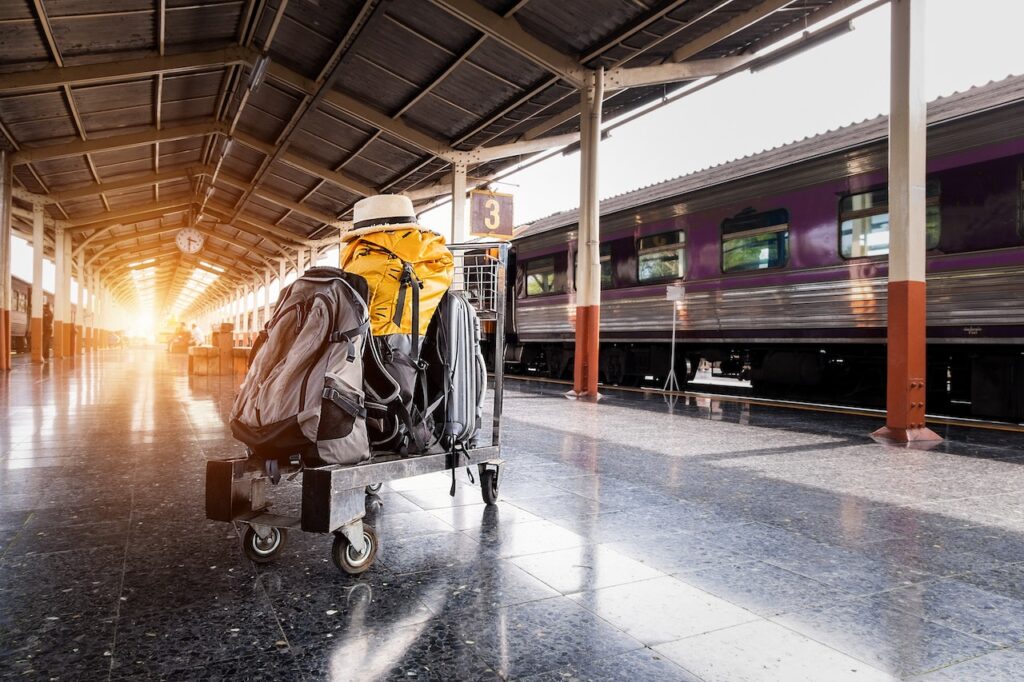Carry-on luggage and personal items are two types of bags that travelers often bring with them on flights. While both serve the purpose of carrying personal belongings, there are key differences between the two that travelers should be aware of before packing. Understanding these differences can help travelers pack more efficiently and avoid any complications at the airport.
Carry-on luggage is typically a larger bag that passengers are allowed to bring into the cabin with them. It must meet the airline’s size and weight restrictions and is stored in the overhead bin during the flight. Personal items, on the other hand, are smaller bags that passengers are allowed to bring with them in addition to their carry-on. These items must fit under the seat in front of the passenger. Knowing the difference between the two can help travelers pack more effectively and avoid any additional fees or complications at the airport.
Key Takeaways
- Understanding the difference between carry-on luggage and personal items can help travelers pack more efficiently.
- Carry-on luggage is typically a larger bag stored in the overhead bin, while personal items are smaller bags stored under the seat.
- Knowing the airline’s policies on carry-on luggage and personal items can help travelers avoid additional fees or complications at the airport.

Understanding Carry on vs Personal Item
Definition of a Carry-On
A carry-on is a piece of luggage that passengers can bring onto the plane with them. It is typically stored in the overhead compartment or under the seat in front of them. Carry-on bags are limited in size and weight, and airlines have specific rules and regulations regarding what is allowed. The size and weight limits vary by airline, but generally, a carry-on bag must be no larger than 22 inches long, 14 inches wide, and 9 inches deep.
Definition of a Personal Item
A personal item is a smaller bag that passengers can bring onto the plane in addition to their carry-on. It is typically stored under the seat in front of them. Personal items are also limited in size and weight, and airlines have specific rules and regulations regarding what is allowed. The size and weight limits vary by airline, but generally, a personal item must be no larger than 18 inches long, 14 inches wide, and 8 inches deep.
Passengers are typically allowed to bring one carry-on bag and one personal item on the plane with them. Examples of personal items include purses, laptop bags, and small backpacks. It is important to note that some airlines may have different rules and regulations regarding what is considered a personal item, so it is always best to check with the airline before traveling.
In summary, understanding the difference between a carry-on and a personal item is important for travelers to ensure they are following airline rules and regulations. Passengers should be aware of the size and weight limits for both types of luggage and should check with the airline before traveling to ensure they are following all guidelines.
Key Differences Between Carry-Ons and Personal Items
Carry-on and personal items are both essential for air travel, but they serve different purposes. Understanding the differences between them can help travelers pack more efficiently and avoid unnecessary fees.
Size and Weight
Carry-on bags are larger and heavier than personal items. Most airlines allow carry-on bags to be up to 22 x 14 x 9 inches and weigh up to 40 pounds. Personal items, on the other hand, are usually smaller and lighter. They can be up to 18 x 14 x 8 inches and weigh up to 20 pounds.
Storage Location
Carry-on bags are stored in the overhead bin, while personal items are stored under the seat in front of the passenger. This means that personal items should be small enough to fit under the seat and not block the passenger’s legroom.
Types of Items Allowed
Carry-on bags can contain a variety of items, including clothes, electronics, and toiletries. However, there are restrictions on liquids and other items that may pose a security risk. Personal items are typically limited to items that can fit under the seat, such as a purse or laptop bag.
In summary, carry-on bags and personal items serve different purposes and have different size and weight restrictions. Travelers should pack accordingly to avoid fees and ensure a comfortable flight.

Airlines’ Policies on Carry-Ons and Personal Items
Common Airline Policies
When it comes to carry-on and personal item policies, airlines have varying rules and regulations. Generally, airlines allow passengers to bring one carry-on bag and one personal item on board. The carry-on bag should fit in the overhead bin and the personal item should fit under the seat in front of the passenger.
The size and weight restrictions for carry-on bags and personal items can differ from one airline to another. For example, American Airlines allows carry-on bags up to 22 x 14 x 9 inches and personal items up to 18 x 14 x 8 inches, while Delta Airlines allows carry-on bags up to 22 x 14 x 9 inches and personal items up to 17 x 13 x 10 inches.
It’s important to check the airline’s website for specific rules and regulations regarding carry-on bags and personal items. In addition, passengers should be aware that some airlines may charge fees for carry-on bags or personal items.
Exceptions and Special Cases
There are some exceptions and special cases when it comes to carry-on and personal item policies. For example, some airlines may allow passengers to bring additional items on board, such as a jacket, umbrella, or duty-free shopping bag.
Passengers traveling with infants or small children may also be allowed to bring additional items on board, such as a diaper bag or stroller. However, it’s important to check with the airline beforehand to ensure that these items are allowed and meet the size and weight restrictions.
Passengers with disabilities or medical conditions may also be allowed to bring additional items on board, such as a wheelchair, medical equipment, or a portable power wheelchair. Again, it’s important to check with the airline beforehand to ensure that these items are allowed and meet the necessary requirements.
Overall, it’s important for passengers to familiarize themselves with the airline’s policies on carry-on bags and personal items to avoid any issues or fees at the airport. By following the rules and regulations, passengers can ensure a smooth and stress-free travel experience.

Tips for Choosing Between a Carry-On and Personal Item
When it comes to packing for a trip, deciding between a carry-on and personal item can be a difficult decision. Here are some tips to help you make the right choice:
Consider Your Travel Needs
The first thing to consider is your travel needs. If you are traveling for a short trip, a carry-on may be all you need. However, if you are traveling for a longer period of time, you may need a personal item in addition to your carry-on.
Consider the purpose of your trip and what items you will need to bring with you. If you are traveling for business, you may need to bring a laptop and other work-related items, which may require a personal item. If you are traveling for leisure, you may only need a carry-on for your clothing and other essentials.
Understanding Airline Restrictions
Another important factor to consider is airline restrictions. Each airline has its own rules and regulations regarding carry-on and personal items, so it’s important to check with your airline before you pack.
Most airlines allow a carry-on bag that is no larger than 22 x 14 x 9 inches and a personal item that is no larger than 18 x 14 x 8 inches. However, some airlines may have different size restrictions or weight limits, so it’s important to check with your airline before you pack.
In addition to size restrictions, some airlines may also have restrictions on the types of items you can bring in your carry-on or personal item. For example, liquids must be in containers that are 3.4 ounces or less and placed in a clear, plastic, quart-sized bag. Other items, such as sharp objects or firearms, may not be allowed in your carry-on or personal item.
By considering your travel needs and understanding airline restrictions, you can make an informed decision on whether to bring a carry-on or personal item on your next trip.
Conclusion
In summary, choosing between a carry-on and personal item depends on the traveler’s specific needs and preferences. Both options have their advantages and disadvantages, and it ultimately comes down to what the traveler deems essential for their trip.
Carry-on bags offer more space and are ideal for longer trips or those who prefer to pack more items. They are also easier to maneuver through the airport and eliminate the need for checked luggage, which can save time and money. However, they may not fit in overhead compartments on smaller planes, and airlines may charge extra fees for larger bags.
On the other hand, personal items such as backpacks or purses are smaller and more convenient for shorter trips or those who prefer to travel light. They are also more versatile and can be used for day-to-day activities during the trip. However, they may not provide enough space for all necessary items and can become uncomfortable to carry for extended periods.
Ultimately, the decision between a carry-on and personal item comes down to personal preference and travel needs. It is important to consider factors such as trip length, destination, and airline regulations before making a decision. By carefully weighing the pros and cons of each option, travelers can make an informed decision and ensure a smooth and stress-free travel experience.

Frequently Asked Questions
What is the difference between a carry-on and a personal item?
A carry-on bag is a larger bag that can be stowed in the overhead bin of an airplane. On the other hand, a personal item is a smaller bag that can be placed under the seat in front of you.
What are the size restrictions for a carry-on bag and a personal item?
The size restrictions for a carry-on bag vary by airline, but generally, the maximum size is around 22 x 14 x 9 inches. For a personal item, the maximum size is usually around 18 x 14 x 8 inches.
Can I bring a backpack as a personal item?
Yes, you can bring a backpack as a personal item as long as it meets the size requirements set by the airline.
What items are allowed in a personal item bag?
You can bring a variety of items in a personal item bag, including a laptop, a book, a small purse, a camera, or any other small item that can fit under the seat in front of you. However, it’s important to note that liquids, gels, and aerosols must be in containers that are 3.4 ounces or less and placed in a clear, plastic, quart-sized bag.
Which airlines allow both a carry-on and a personal item?
Most airlines allow both a carry-on bag and a personal item. However, the size restrictions may vary by airline, so it’s important to check with the airline before you travel.
What is the best personal item bag for air travel?
The best personal item bag for air travel is one that is lightweight, durable, and has enough compartments to keep your belongings organized. Some popular options include backpacks, tote bags, and messenger bags.



